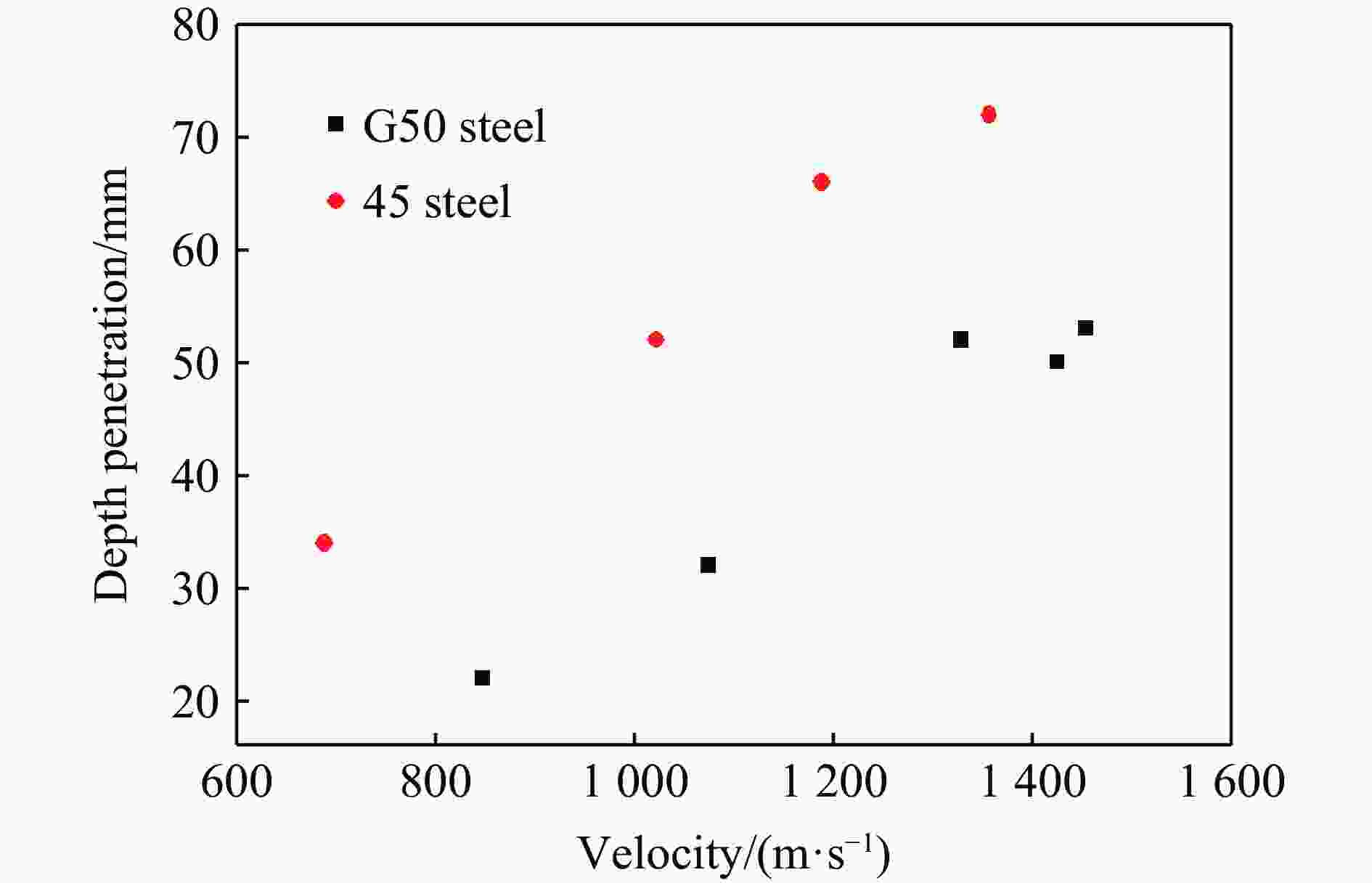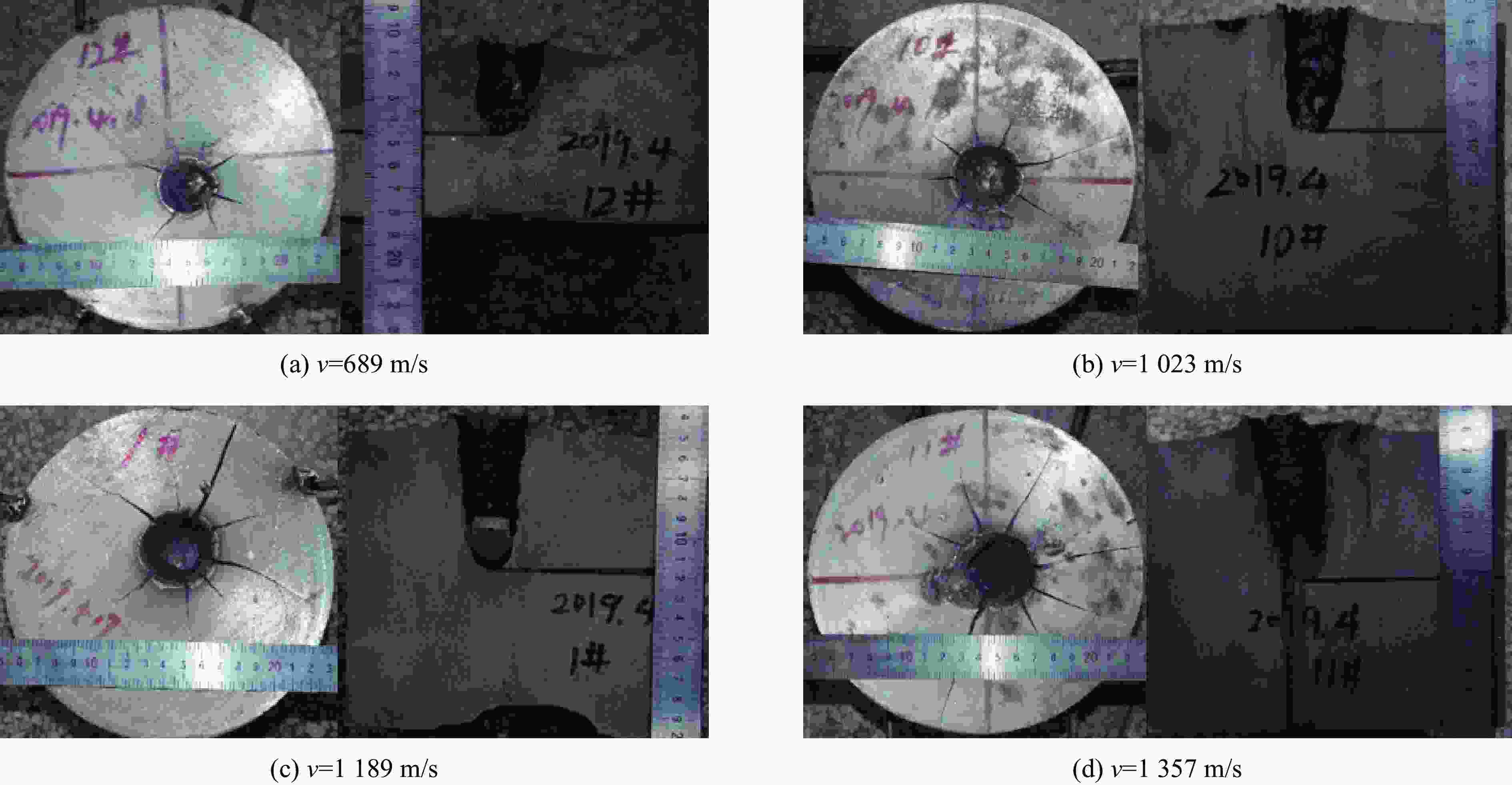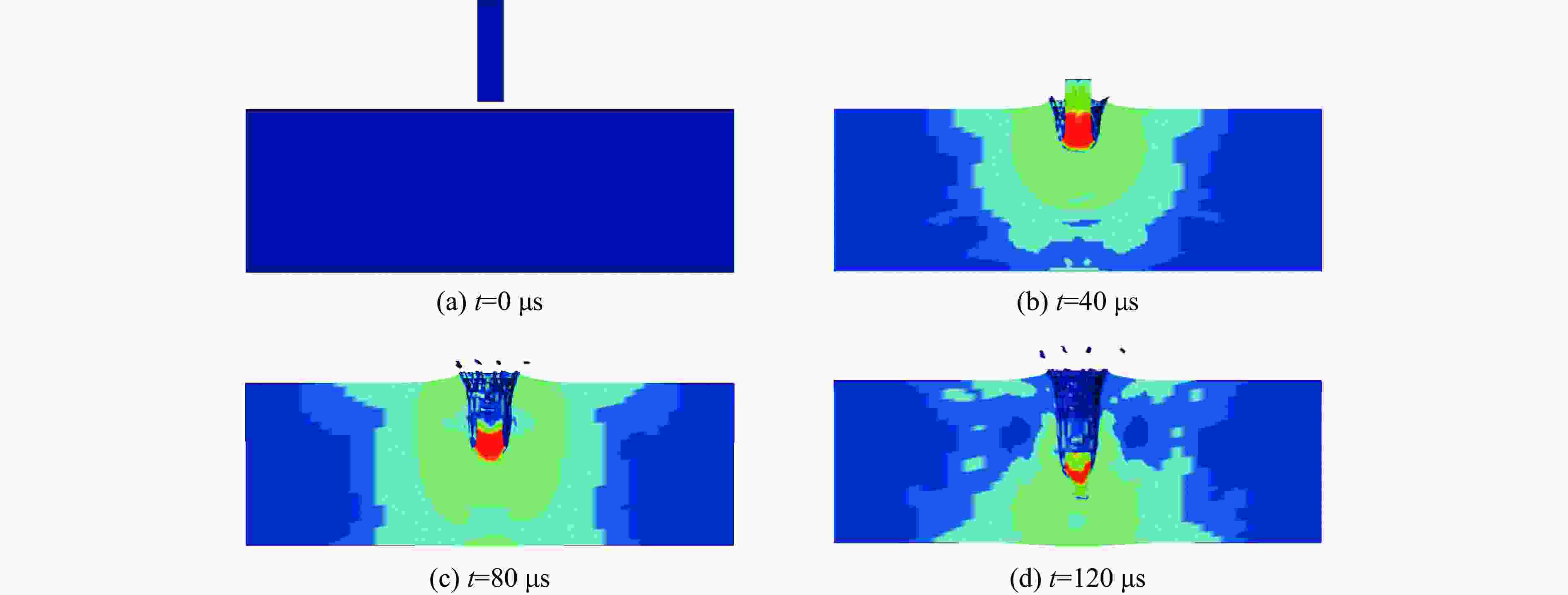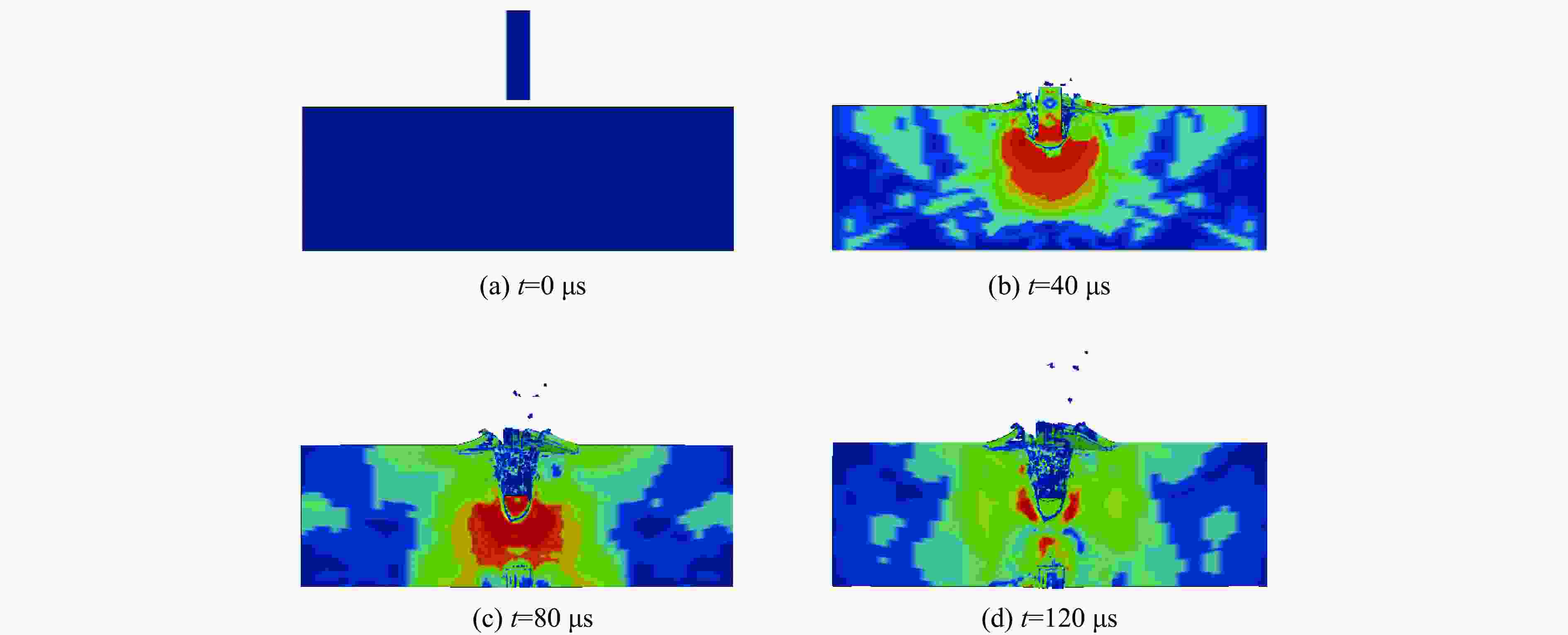Characteristics of high-mass tungsten alloy kinetic projectile penetrating ultra-high strength steel targets at high velocity
-
摘要: 为研究超高强度钢靶抗大质量钨合金动能块的侵彻性能及破坏特性,基于弹道炮开展了215 g圆柱形钨合金动能块高速侵彻半无限超高强度G50钢靶和低强度45钢靶试验,获得了不同速度侵彻下两种钢靶的侵彻深度和成坑体积。试验表明,不同于低强度钢靶的近似圆柱体成坑特性,钨合金动能块侵彻超高强度钢靶时,在靶板内形成了类锥形弹坑,成坑侧面和坑底均有拉伸崩落裂纹;分析了超高强度钢靶的侵彻破坏特性,指出侵彻过程中钨合金动能块局部破碎引起靶板内的卸载拉伸剥落和动能块的侵彻锐化行为联合导致了类锥体弹坑的形成。通过数值模拟验证了超高强度钢靶的高速侵彻破坏机制。Abstract: To study the penetration performance and failure characteristics of ultra-high strength steel targets against high-mass tungsten alloy kinetic projectiles with different impact velocities, a ballistic gun was used to carry out 215 g tungsten alloy kinetic projectiles to impact the ultra-high strength G50 steel and 45 steel targets at velocities in the range of 689−1489 m/s. According to the experimental results, a conic-like crater was observed in the ultra-high strength steel target against a tungsten alloy kinetic projectile, which was different from the column-like crater mode observed in the experiments of 45 steel targets. It was also observed that there were several unique tensile spall cracks on the crater surface and bottom for the ultra-high strength steel. The depth of penetration (DOP) and the crater volume of these two steel targets were further obtained, which showed that the DOP of G50 steel targets is shorter than that of 45 steel at similar penetration velocity, while the corresponding crater volume is greater than that of 45 steel. Based on the interaction mechanism between the projectile and target, the high-mass tungsten alloy kinetic projectiles are considered to undergo local fragmentation under high radial stress during penetration into the G50 steel target, resulting in unloading tensile waves within the target. It is believed the unloading waves within the target lead to the spalling damage of the crater wall, resulting in the fish-scale-like rough walls and spallation cracks. This also explains why the crater volume of G50 steel is greater than that of 45 steel. In addition, the sharpening effect was caused by the local fragmentation of the kinetic projectile head. Therefore, it is considered that this failure mode was mainly caused by both the tensile fracture of the target induced by the local fragmentation of the projectile and the sharpening behavior of the projectile. Numerical simulations of the penetration of high-mass tungsten alloy projectiles into ultra-high strength steel targets were further performed to demonstrate the entire process of deformation, damage, and failure of the target plate and projectile, which further validated the failure mechanism of the targets.
-
密度/(kg·m−3) 屈服强度/MPa 抗拉强度/MPa 延伸率/% 洛氏硬度 7850 ≥1330 ≥1660 10 45 表 2 G50钢靶的侵彻毁伤特性
Table 2. The penetration failure characteristics of the G50 steel targets at different impact velocities
撞击速度/(m∙s−1) 开孔直径/mm 穿深/mm 侵彻弹道容积/cm3 848 60 22 33 1075 70 32 54 1329 43 52 86 1425 47 50 97 1455 65 53 87 表 3 45钢靶的侵彻毁伤特性
Table 3. The penetration failure characteristics of the 45 steel targets at different impact velocities
撞击速度/( m∙s−1) 开孔直径/mm 穿深/mm 侵彻弹道容积/cm3 689 29 34 17 1023 31 52 28 1189 34 66 39 1357 37 72 47 表 4 弹靶材料的Johnson-Cook参数
Table 4. Johnson-Cook model parameters ofprojectile and targets
材料 A/MPa B/MPa n c m Tmelt/K G50钢 1445 1326 0.356 0.005 1.12 1793 45钢 496 434 0.307 0.008 0.80 1793 93W 1197 580 0.050 0.025 1.90 1730 表 5 弹靶材料的Grüneisen状态方程参数
Table 5. Grüneisen state equation parameters ofprojectile and targets
材料 c/(m∙s−1) S1 S2 S3 γ0 A G50钢 4280.0 1.990 0 0 2.170 0.46 45钢 4280.0 1.990 0 0 2.170 0.46 93W 4066.2 1.368 0 0 1.736 0.46 表 6 45钢的侵彻深度数值模拟结果
Table 6. Numerical simulation results of DOP of 45 steel
撞击速度/( m∙s−1) 试验穿深/mm 模拟穿深/mm 侵深误差/% 689 34 25.3 25.6 1023 52 49.5 4.95 1189 66 68.9 4.41 1357 72 76.7 6.46 表 7 G50钢的侵彻深度数值模拟结果
Table 7. Numerical simulation results oof DOP of G50 steel
撞击速度/( m∙s−1) 试验穿深/mm 模拟穿深/mm 侵深误差/% 848 22 24.6 11.7 1075 32 37.5 17.1 1329 52 45.9 11.7 1425 50 52.3 4.53 1455 53 53.5 0.94 -
[1] HOHLER V, STILP A J. Penetration of steel and high density rods in semi-infinite steel targets [C]//Proceedings of the 3rd International Symposium on Ballistics. Karlsruhe, 1977: 23–25. [2] SCHÄER F K, HERRWERTH M, HIERMAIER S J, et al. Shape effects in hypervelocity impact on semi-infinite metallic targets [J]. International Journal of Impact Engineering, 2001, 26(1): 699–711. DOI: 10.1016/s0734-743x(01)00115-4. [3] DUAN Z Q, LI S X, HUANG D W. Microstructures and adiabatic shear bands formed by ballistic impact in steels and tungsten alloy [J]. Fatigue & Fracture of Engineering Materials & Structures, 2003, 26(12): 1119–1126. DOI: 10.1046/j.1460-2695.2003.00705.x. [4] MARTINEAU R L, PRIME M B, DUFFEY T. Penetration of HSLA-100 steel with tungsten carbide spheres at striking velocities between 0.8 and 2.5 km/s [J]. International Journal of Impact Engineering, 2004, 30(5): 505–520. DOI: 10.1016/S0734-743X(03)00080-0. [5] 谭多望, 李翔, 温殿英, 等. 球形钨合金破片终点弹道性能实验研究 [J]. 爆炸与冲击, 2003, 23(5): 425–429.TAN D W, LI X, WEN D Y, et al. Experimental investigation of terminal effects of spherical tungsten fragments [J]. Explosion and Shock Waves, 2003, 23(5): 425–429. [6] 徐豫新, 王树山, 伯雪飞, 等. 钨合金球形破片对低碳钢的穿甲极限 [J]. 振动与冲击, 2011, 30(5): 192–195. DOI: 10.3969/j.issn.1000-3835.2011.05.040.XU Y X, WANG S S, BO X F, et al. Armor-piercing ultimate of tungsten alloy spherical fragment against low-carbon steel [J]. Journal of Vibration and Shock, 2011, 30(5): 192–195. DOI: 10.3969/j.issn.1000-3835.2011.05.040. [7] 徐豫新, 任杰, 王树山. 钨球正撞击下低碳钢板的极限贯穿厚度研究 [J]. 北京理工大学学报, 2017, 37(6): 551–556. DOI: 10.15918/j.tbit1001-0645.2017.06.001.XU Y X, REN J, WANG S S. Research on perforation limit thickness of low carbon steel plates impacted normally by tungsten spheres [J]. Transactions of Beijing Institute of Technology, 2017, 37(6): 551–556. DOI: 10.15918/j.tbit1001-0645.2017.06.001. [8] 赵晓旭, 王树山, 徐豫新, 等. 钨球高速侵彻低碳钢板成坑直径的计算模型 [J]. 北京理工大学学报, 2015, 35(12): 1217–1221. DOI: 10.15918/j.tbit1001-0645.2015.12.002.ZHAO X X, WANG S S, XU Y X, et al. Crater diameter calculation model of tungsten sphere impacting low carbon steel plate at high velocity [J]. Transactions of Beijing Institute of Technology, 2015, 35(12): 1217–1221. DOI: 10.15918/j.tbit1001-0645.2015.12.002. [9] 赵小峰. 破片质量对钨合金破片侵彻威力的影响 [J]. 科学技术与工程, 2020, 20(10): 3967–3971. DOI: 10.3969/j.issn.1671-1815.2020.10.025.ZHAO X F. Impact of fragment mass on the penetration capacity of tungsten alloy fragment [J]. Science Technology and Engineering, 2020, 20(10): 3967–3971. DOI: 10.3969/j.issn.1671-1815.2020.10.025. [10] 王雪, 智小琦, 徐锦波, 等. 球形破片侵彻多层板弹道极限的量纲分析 [J]. 高压物理学报, 2019, 33(6): 065102. DOI: 10.11858/gywlxb.20190757.WANG X, ZHI X Q, XU J B, et al. Dimensional analysis of ballistic limit of spherical fragments penetrating multi-layer plate [J]. Chinese Journal of High Pressure Physics, 2019, 33(6): 065102. DOI: 10.11858/gywlxb.20190757. [11] 刘铁磊, 徐豫新, 王晓锋, 等. 钨合金球形破片侵彻低碳钢的弹道极限速度计算模型 [J]. 兵工学报, 2022, 43(4): 768–779. DOI: 10.12382/bgxb.2021.0448.LIU T L, XU Y X, WANG X F, et al. Ballistic limit calculation model of tungsten alloy spherical fragments penetrating into low carbon steel plate [J]. Acta Armamentarii, 2022, 43(4): 768–779. DOI: 10.12382/bgxb.2021.0448. [12] 张健, 徐豫新, 刘铁磊, 等. 钨球对高硬度钢斜侵彻效应 [J]. 爆炸与冲击, 2022, 42(2): 023302. DOI: 10.11883/bzycj-2021-0427.ZHANG J, XU Y X, LIU T L, et al. Oblique penetration effect of a tungsten ball on high hardness steel [J]. Explosion and Shock Waves, 2022, 42(2): 023302. DOI: 10.11883/bzycj-2021-0427. [13] 王猛, 黄德武, 荣光, 等. 装甲板弹坑底部冠状裂纹的观测与分析 [J]. 兵工学报, 2009, 30(12): 1579–1583. DOI: 10.3321/j.issn:1000-1093.2009.12.003.WANG M, HUANG D W, RONG G, et al. Observation and analysis of coronary cracks beneath the crater in armor-plate [J]. Acta Armamentarii, 2009, 30(12): 1579–1583. DOI: 10.3321/j.issn:1000-1093.2009.12.003. [14] 北京跟踪与通信技术研究所. 美动能拦截弹的发展现状和趋势分析 [J]. 科技情报快讯, 2010, 2: 1–25. DOI: 10.3969/j.issn.1009-086X.2008.04.006.Beijing Institute of Tracking and Communication Technology. Current technology and development trend of American kinetic missions [J]. Science and Technology Intelligence News, 2010, 2: 1–25. DOI: 10.3969/j.issn.1009-086X.2008.04.006. [15] 中国人民解放军总装备部. 28CrMnSiNi4MoNb钢棒规范: GJB 8545−2015 [S]. 2015.People’s Liberation Army General Armaments Department. Specification for 28CrMnSiNi4MoNb steel bars: GJB 8545−2015 [S]. 2015. [16] FORRESTAL M J, LUK V K. Dynamic spherical cavity-expansion in a compressible elastic-plastic solid [J]. Journal of Applied Mechanics, 1988, 55(2): 275–279. DOI: 10.1115/1.3173672. [17] 李金泉. 穿甲侵彻机理及绝热剪切带特性研究 [D]. 南京: 南京理工大学, 2005. DOI: 10.7666/d.y1001823.LI J Q. Study of armour-piercing mechanism and adiabatic shear banding characteristic [D]. Nanjing: Nanjing University of Science and Technology, 2005. DOI: 10.7666/d.y1001823. [18] 段占强, 丛美华, 苏会和, 等. 45#钢高速冲击穿孔的显微组织 [J]. 材料研究学报, 2001, 15(4): 403–408. DOI: 10.3321/j.issn:1005-3093.2001.04.005.DUAN Z Q, CONG M H, SU H H, et al. Microstructure investigation of the penetration bore of 45# steel in high speed impacting [J]. Chinese Journal of Materials Research, 2001, 15(4): 403–408. DOI: 10.3321/j.issn:1005-3093.2001.04.005. [19] 李金泉, 黄德武, 段占强, 等. 穿甲侵彻过程中靶板内绝热剪切带特性及形成原因分析 [J]. 兵工学报, 2005, 26(1): 60–63. DOI: 10.3321/j.issn:1000-1093.2005.01.013.LI J Q, HUANG D W, DUAN Z Q, et al. Analysis on adabiatic shear band characteristic and cause of formation in process of penetration in armor [J]. Acta Armamentarii, 2005, 26(1): 60–63. DOI: 10.3321/j.issn:1000-1093.2005.01.013. [20] ROHR I, NAHME H, THOMA K, et al. Material characterisation and constitutive modelling of a tungsten-sintered alloy for a wide range of strain rates [J]. International Journal of Impact Engineering, 2008, 35(8): 811–819. DOI: 10.1016/j.ijimpeng.2007.12.006. [21] 王可慧, 张颖, 段建, 等. G50钢的力学性能实验研究 [J]. 兵工学报, 2009, 30(S2): 247–250.WANG K H, ZHANG Y, DUAN J, et al. Experimental research on the mechanical properties of G50 alloy steel [J]. Acta Armamentarii, 2009, 30(S2): 247–250. [22] 王猛, 黄德武, 曲家惠, 等. 钨合金杆式弹侵彻45#钢变形失效行为的数值分析 [J]. 塑性工程学报, 2012, 19(2): 102–106. DOI: 10.3969/j.issn.1007-2012.2012.02.021.WANG M, HUANG D W, QU J H, et al. Simulation on the deformation and fracture of long-rod projectile of tungsten alloy penetrating into 45# steel [J]. Journal of Plasticity Engineering, 2012, 19(2): 102–106. DOI: 10.3969/j.issn.1007-2012.2012.02.021. -







 下载:
下载:















